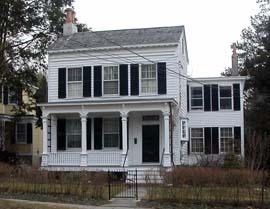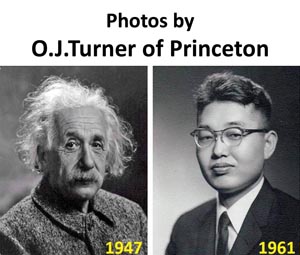Heisenberg, Dirac, and Wigner

|
-
Einstein lived in this Princeton house until he left us in 1955.
Some important people visited this house to talk with
Einstein. One of them was
- Irene Joliot-Curie (Nobel'35 in chemistry), Marie Curie's daughter. She was 18 years younger than Einstein.
In 1954, another important person visited this house. His name was Werner Heisenberg. According to Heisenberg's memoir, Einstein was kind enough to spend an entire afternoon with him even though he had an appointment for one hour. On the other hand, according to Johanna Fantova, Einstein was not very happy with Heisenberg.
In either case, their meeting did not produce any new result in physics. Heisenberg invented his uncertainty relation twenty two years after Einstein formulated his special theory of relativity in 1905. Thus, Heisenberg should have brought with him a scientific result which could make Einstein happy. The best result could have been that his uncertainty relation is consistent with Einstein's Lorentz covariance. The question then is whether Heisenberg had enough resources at that time.

|

|

|
According to this photo, Dirac was not a stranger to Heisenberg. In his 1949 paper, Dirac attempted to make his "Poisson brackets" consistent with special relativity in order to make Einstein happy. Heisenberg should have known that Dirac's Poisson brackets are the commutators for his uncetainty relations.
In the same paper, Dirac introduced his light-cone coordinate system. The unlike space and time variables, the light-cone variables do not mix with each other. Under Lorentz boosts, one of the variables contracts while the other expands. Here is the light-cone geometry. We can then rotate this by 45 degrees to transform this to a geometry of rectangles.
Thus, the Lorentz-invariant form of his uncertainty relation was within Heisenberg's reach. Here is a simple calculation to explain this geometry.
30 year later
-
In 1984, I felt like presenting this case to
Einstein, but he was not available. Princeton's highest priest was
Eugene Wigner. Dirac was Wigner's
famous-brother-in-law. My assumption was that Wigner was
quite familiar with Dirac's 1949 paper on the forms of relativistic
dynamics.
I thus decided to approach Wigner, but I had to make a complete and thorough preparation. The light-cone uncertainty can be best described with Wigner functions. I then studied Wigner functions using harmonic oscillators, and made preparations for an international conference on the physics of phase space. With this preparation, I went to Princeton in 1985 to talk with Wigner. He was very happy to talk about Wigner functions and Dirac's light-cone coordinate system. Wigner knew many other things.

|
| Phys. Rev. A. {38}, 1167 (1988). |

|
In this figure, the uncertainty is the area within the circle or ellipse which remains invariant under Lorentz boosts.
Wigner came to the University of Maryland several times. He attended the international conference on the physics of phase space which was held in 1986 at the University of Maryland. He was invited to the president's residence for a breakfast, and I went with him. this photo.
The president of the University at that time was John S. Toll. Toll was John A. Wheeler's student at Princeton. He hired me in 1962 when he was the chairman of the physics department. Toll once told me my best gift to Wigner was to study his papers. He was talking like a university president.
Wheeler was not my advisor, but I was crazy enough to be remembered by him. I maintain a webpage consisting of Wheeler photos. I seem to use figures and photos effectively to communicate with you. This is Wheeler's influence. I like Dirac's papers. They are like poems, but Dirac did not know how to draw figures. It is fun to add pictures to Dirac's papers.
Was Dirac a stranger to me? If you have some Bible background, you should know that Nicodemus secretly went to Jesus to find out about himself. He did not like the society to which he belonged and was seeking new wisdom. Likewise, in 1962, I did not like what my noisy colleagues were doing. We used to call them "band-wagoners." I was fortunate enough to have a private audience with Dirac. Here is what Dirac told me.
I seem to have circles and ellipses in my papers. They are also very useful tools in optical sciences. You may click here to see what I am doing there.
Y. S. Kim (2009.7.31)
- copyright@2009 by Y. S. Kim, unless otherwise specified.

Who is this young man? The photo of Dirac and Heisenberg from the AIP Emilio Segre Visual Archives, Physics Today Collection. The photo of Dirac and Wigner also from the AIP Emilio Segre Visual Archives.
- Click here for Y. S. Kim's home page.